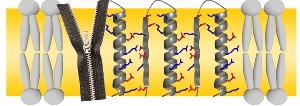Membrane proteins are the “molecular machines” in biological cell envelopes. They control diverse processes, such as the transport of molecules across the lipid membrane, signal transduction, and photosynthesis. Their shape, i.e. folding of the molecules, plays a decisive role in the formation of, e.g., pores in the cell membrane. In the Cell magazine, researchers of Karlsruhe Institute of Technology and the University of Cagliari are now reporting a novel charge zipper principle used by proteins to form functional units (DOI: 10.1016/j.cell.2012.12.017).
“It is fascinating to see the elegant basic principles that are used by nature to construct molecular assemblies,” explains Anne Ulrich, Director of the KIT Institute for Biological Interfaces. “A charge zipper between the charged side chains is an entirely unexpected mechanism used by membrane proteins to neutralize their charges such that they can be immersed into hydrophobic cell membranes.”
In the study published now, Ulrich and her team investigate the so-called Twin-arginine translocase (Tat) that is used in the cell membrane of bacteria as an export machinery for folded proteins. Several TatA subunits assemble as a pore that can adapt its diameter to the size of the cargo to be transported. “But how can such a pore be built up from TatA proteins? How can they reversibly form a huge hole in the membrane for a variety of molecules to pass through, but without causing leakage of the cell?”, Ulrich formulates the questions studied.
To answer these questions, the researchers studied the molecular structure of TatA protein from the bacterium B. subtilis, which consists of a chain of 70 amino acids. The analysis showed that it folds into a rather rigid, rod-shaped helix that is followed by a flexible, extended stretch. Many amino acids in the helix and the adjacent stretch carry positive or negative charges. Surprisingly, the sequence of charges on the helix is complementary to those in the adjacent stretch of the protein. When the protein is folded up at the connection point like a pocket knife, positive and negative charges will always meet and attract each other. Hence, the protein links up both of its segments, similar to the interlocking teeth of a zipper.
“The clou is that this binding principle also works with the neighboring proteins,” Ulrich says. Instead of folding up alone, every TatA protein also forms charge zippers with both of its neighbors. Computer simulations showed that this leads to stable and, at the same time, flexible connections between the adjacent molecules. In this way, any number of proteins can be linked together to form an uncharged ring, which thus lines the TatA pore in the hydrophobic membrane. This novel charge zipper principle does not only seem to play a role in protein transport, but also in the attack of certain antimicrobial peptides on bacteria, or in their formation of biofilms as a response to stress.
More information on the working group:
Being “The University in the Helmholtz Association”, KIT creates and imparts knowledge for the society and the environment. It is the objective to make significant contributions to the global challenges in the fields of energy, mobility, and information. For this, about 10,000 employees cooperate in a broad range of disciplines in natural sciences, engineering sciences, economics, and the humanities and social sciences. KIT prepares its 22,800 students for responsible tasks in society, industry, and science by offering research-based study programs. Innovation efforts at KIT build a bridge between important scientific findings and their application for the benefit of society, economic prosperity, and the preservation of our natural basis of life. KIT is one of the German universities of excellence.

